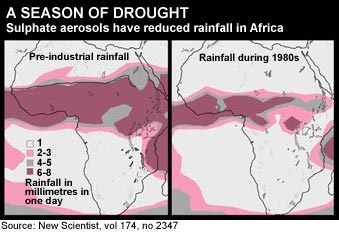Picture imperfect
 Scientists are yet to unravel all the mysteries about the tiny and yet complex three-dimensional particles. Key details about their properties and their effects remain elusive. So far, it has not been possible to make reliable measurements to determine their distribution and properties on a global scale. Large uncertainties remain in estimating the magnitude of various aerosols emitted from different sources. Studies based on indoex data are quite preliminary in nature, however, latest results provide an indication of their potential to impact climate scenarios, rainfall and agriculture.
Scientists are yet to unravel all the mysteries about the tiny and yet complex three-dimensional particles. Key details about their properties and their effects remain elusive. So far, it has not been possible to make reliable measurements to determine their distribution and properties on a global scale. Large uncertainties remain in estimating the magnitude of various aerosols emitted from different sources. Studies based on indoex data are quite preliminary in nature, however, latest results provide an indication of their potential to impact climate scenarios, rainfall and agriculture.
Transboundary findings
The indoex experiment showed that aerosols could be transported to long distances away from the emitting region. Soot lodged in sub-micron sulphate and organic aerosols was seen in distant south showing that these have a lifetime of over a week. The project also fuelled doubts about similar large-scale transport of pollution occurring in other regions of the Earth. Pollutants from Asia are being transported across the Pacific Ocean by winds. Massive dust storms in Asia, which also carry sulphate and organic aerosols, transport soil eastward to Japan and across the Pacific to the us.
However, developing countries have borne far worse consequences of industrialisation than the Northern countries. A recent study by Leon Rotstayn and Ulrike Lohmann, Dalhousie University, Australia, has revealed that sulphate aerosols formed upon oxidation of sulphur dioxide emissions from industries in North America and Europe may have been responsible for causing severe droughts in the Sahel region of Africa in the 1980s. Precipitation in this region has fallen by between 20 and 50 per cent in the last 30 years. Also, these emissions may have led to a greater rainfall in Australia as the tropical rain belt shifted southwards (see map: A season of drought).
On the other hand, dust storms from Africa's arid Sahelian region, which can rise up to four kilometres into the sky, travel across the Atlantic Ocean to Florida and put about 500 million to 1 billion tonnes of dust into the atmosphere. The incidence of dust clouds reaching Florida has increased since the drought in the Sahel region.
Transcontinental dust clouds originating from Asia and Africa are the most significant for North America as itcz along the equator acts as a sort of wind barrier to separate the storms of the Northern and Southern Hemispheres. The Sahel region, the Sahara desert, the Indus valley in India, the Taklimakan desert north of the Himalayas and the Gobi desert in Mongolia, are a few main sources of dust in the world. Surface wind blowing at high speeds over the desert and low sparse grassland regions in Mongolia and western China can inject enormous plumes of dust high into the atmosphere. These are then transported as far as the Pacific Ocean basin before being depleted by rain or gravitational pull.
Compared with the clouds from Africa, Asian dust shows higher concentration of human caused air pollutants such as sulphates, perhaps due to Asia's dense population and industrial cities. For instance, dust storms from the Mongolian region start from severely eroded soils, due to overgrazing and overfarming, and as these dust clouds pass over Beijing and other large cities, they gather industrial pollutants.
Apart from the health effects associated with particulate matter, mineral constituents of dust present an added hazard (see box: Killers at large). Fine iron particles, which give the reddish tinge to the African dust, can generate hydroxyl radicals on the lung surface, which can scar lung tissue over time and decrease its effectiveness. Another important feature of transcontinental dust clouds is the microbes they transport. Initially it was believed that ocean distances were too large for bacteria to survive, but research points that intercontinental dust may transmit viable pathogens. In thick clouds of dust, the uv exposure at the bottom can be just half of that at the upper surface, so microbes in the lower layer can be protected and can survive the transport.
Pathogens carried in dust can cause skin infections such as rashes and open sores, and may affect crops like cotton, peaches and rice. Indirectly, dust aerosols can impact nutrition by reducing crop yields
